Moon Sports > Basketball > Eliminate the weaknesses of the arena successfully! Edwards has said goodbye to himself in the past
Eliminate the weaknesses of the arena successfully! Edwards has said goodbye to himself in the past
The Timberwolves won again at the Warriors' home court, and Edwards also continued his excellent performance and scored 30+ consecutively. More importantly, he has completed the optimization of his weaknesses. This issue of the column will take you to understand through in-depth data analysis.
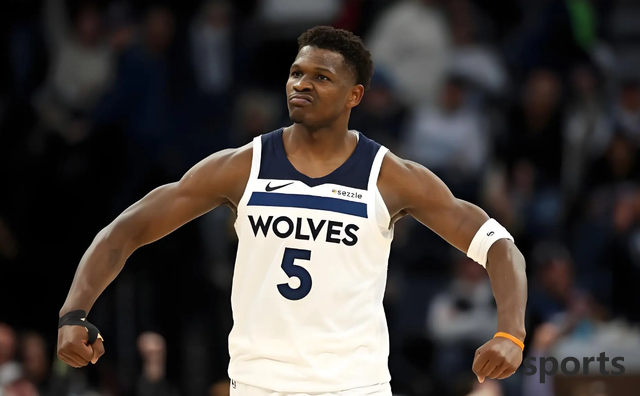
The Timberwolves once reached the Western Conference Finals last season but eventually lost. Edwards also exposed his weakness: when the opponent uses double-team defense against him, his offensive success rate will decrease and pass mistakes will increase significantly. But as he travels this season's playoff journey, he has found a way to deal with the double-team strategy, which is also the key to his ability to score 30 points in a row. So what changes have he made?

The first change was the change of teammates. Of course, this may not be his active change. The other offensive core of the team last season was Towns. Towns was a player who ended up. In addition, point guard Conley was too old, so last season's Timberwolves actually had only Edwards one offensive starting point:
In the playoffs last season, Edwards' non-assisted rate reached 70.5%. Combined with Edwards' main player's assist rate of 27.7%, Edwards actually had a large core offensive system with the ball in his possession. In addition, he was not a player with outstanding offense, which also led to his opponent's double-teaming strategy being very effective.
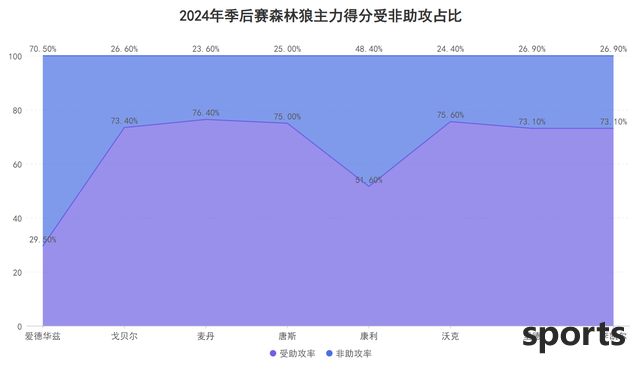
However, the situation is different this season. Although Edwards' non-assisted rate is still the first in the main team, it has dropped to 48.8%, and the assist rate of the score has increased significantly. In addition to Gobert, who scored more second-time offenses, his scoring proportion with Randle's non-assisted scores is very close to Randle's score. Combined with Randle's main team's assist rate of 28.1%, the Timberwolves are now an offensive system launched by dual-cores. Both of them can send assists and can end the ball by themselves. Randle has undertaken the most organizational tasks, so Edwards no longer needs to play the role of holding the ball and holding the ball, and he has more catch and end.
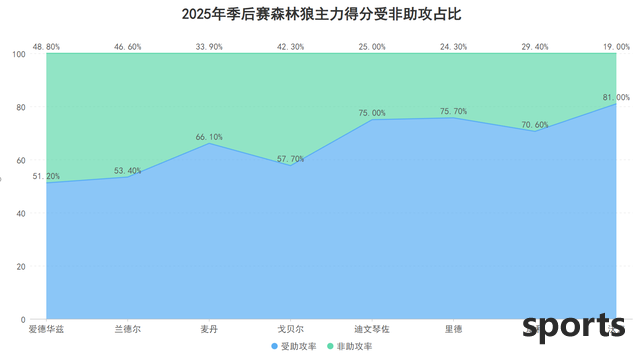
The end of the ball means that Edwards is in a state of no ball more time. In all areas on the offensive end, Edwards has a certain proportion of assisted attacks in all areas except for mid-range. In the absence of ball, the opponent cannot use double-team unless it is extreme. This leads to Edwards having more chances of receiving the ball out of the phone, and also reduces the possibility of being double-teamed. In addition, he can take the ball at any time and starts the ball-holding attack again, making the offense more diversified, making it difficult for the opponent to use double-team defense.

The second change is the offensive area. Last season, Edwards had a high proportion of mid-range shots, while this season Edwards's was more concentrated in the three-second zone and outside the three-point line.
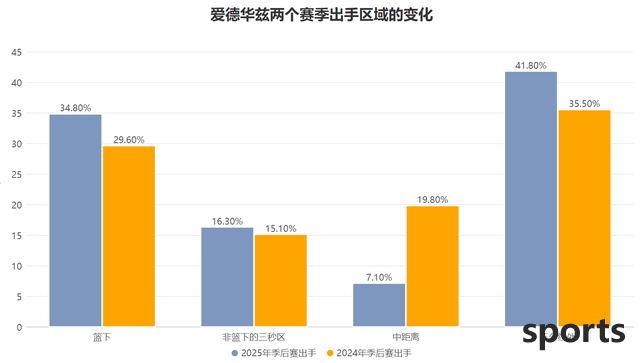
If the opponent outside the three-point line adopts double-team, Edwards will have more room to allocate the ball to his teammates, and his teammates will also have greater room to shoot. Although the opponent can also use double-team in the three-second zone, Edwards can choose to drill back and squeeze in in this zone and score or make a foul directly. The changes in the main offensive area also make it difficult for the opponent to use double-team or double-team to pay a greater price.
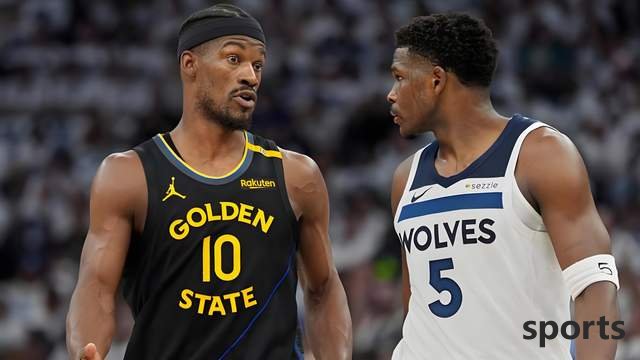
The third change is the offensive method. If he really falls into positional battles, the opponent will naturally form a stable defensive system. Therefore, Edwards pays more attention to offensive and defensive conversions. Before the opponent's defense is formed, Edwards used his high movement and flexibility to score. Edwards averaged offensive and defensive conversions per game in the playoffs of 3.4 times, and his effective shooting percentage after combining the three-point shootings reached the highest of 68.5% of the 10 players with the most offensive and defensive conversions per game. His offensive and defensive conversion production is more sufficient and efficient enough.
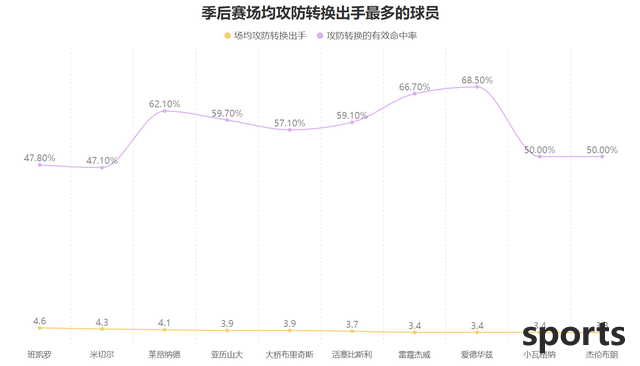
Teammates share the ball-holding task, main offensive area and avoid falling into positional battles. Of course, the increase in consciousness and experience gradually adapting to being double-teamed is also the talent of the No. 1 pick. He has bid farewell to the past self who was overwhelmed by double-teaming.
Related Posts
TA selected the top ten wonderful moments of the 21st century: James ranked first in the tiebreaker with 81%; Kobe ranked second with 81
BasketballNovember 22nd, the American media TheAthletic selected the top ten NBA moments since the 21st century. Among them, James ranked first with his biggest shot in G7 of the 2016 Finals, Kobe's 81 points ranked second, and Ray Allen's corner thre...
moreThe Mavericks are preparing for a major overhaul. The player supermarket has opened, and many main players have been put on the shelves. They will rebuild around the No. 1 pick.
BasketballThe Dallas Mavericks have had a devastating start to the season. In fact, at the beginning of the season, the outside world was relatively optimistic about the Mavericks. With the addition of the No. 1 pick, and no injuries to the team, they were al...
moreCollins started 6 games, averaging 9.3 points, 4.5 rebounds and 0 assists, shooting 40.7%% from the field and 13.3% from three-point range.
BasketballHupu News November 21st NBA regular season, the Clippers lost to the Magic 101-129 and suffered a three-game losing streak. In this game, Clippers player John Collins made 4 of 8 shots, 0 of 1 three-pointers, scored 9 points, 4 rebounds, 1 steal, 1...
more
Hot Posts
- Best Rookie? No. 4 overall pick Knipur, how amazing is he?
- Carter Jr.: We know what Blake is capable of and the team is stronger when he stays aggressive
- Seth Curry - Brothers on the same stage, Seth fights for the championship
- Anthony is officially inducted into the Hall of Fame! Maybe he only retired from the Knicks No. 7, but the Nuggets No. 15 cannot retire?
- NBA offseason turmoil: The giant chess game behind a billion-dollar contract
- Scott: Tatum seems to die when his Achilles tendon breaks, but Kobe will never do this
- American News: The Cavaliers don t need to trade core players such as Garland. They still have great potential if they are not the Lakers.
- Successfully played the role of the surprise! The Pacers forward performs amazingly in overtime?
- Questioning the Mavericks to Becoming the Mavericks! Famous reporter: Antetokounmpo is on his way to the Lakers
- Homegren burst! Thunder 149-106 Nuggets, Alexander watches 34+4+7, Harten 14+8+5
Recent Posts
-
The Clippers will have problems, but they will also solve them, so how did the Clippers make a comeback?
-
Confirm! NBA Finals Battle! Thank you, Paul George
-
Dearly the Business League! The referee leads the game, the Pacers lead 30 points, and the tiebreak battle is coming
-
Understand basketball emperor-In-depth analysis of sports lottery 302WNBA: Freeman vs. Ace
-
The semi-finals of the playoffs were born! Set an NBA record, with 3 winners and 3 losers, Curry was questioned
-
30 points in the life-and-death battle! Timberwolves scored 9 points in a single quarter, Edwards was eliminated in 7 of 18 shots
-
From 1984 to 1986, Bird s MVP three consecutive MVPs, but in 1987, he could only rank third in the MVP list. Who are the top two?
-
US media commented on the 10 most underrated deals this summer: Lakers sign Ayton with high cost performance, Nuggets top
-
Lang Youqing, no intention, no intention, the Basketball Association, no intention to pay for naturalization, Guo Shiqiang was in trouble, the person involved: No one contacted me
-
Middle-class target players choose one of two, experts reveal that the Rockets will sign Smith and Trent may be a better choice